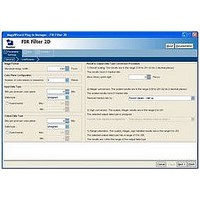IPSR-VIDEO Altera, IPSR-VIDEO Datasheet - Page 49

IPSR-VIDEO
Manufacturer Part Number
IPSR-VIDEO
Description
RENEWAL Of IPS-VIDEO
Manufacturer
Altera
Series
IP Suitesr
Datasheet
1.IPS-VIDEO.pdf
(202 pages)
Specifications of IPSR-VIDEO
Software Application
IP CORE, SUITES
Supported Families
Arria GX, Cyclone II, HardCopy II, Stratix II
Features
Common Avalon Streaming (Avalon-St) Interface And Avalon-St Video Protocol
Core Architecture
FPGA
Core Sub-architecture
Arria, Cyclone, Stratix
Rohs Compliant
NA
Lead Free Status / RoHS Status
na
- Current page: 49 of 202
- Download datasheet (6Mb)
Chapter 3: Parameter Settings
Deinterlacer
Table 3–13. Deinterlacer Parameter Settings (Part 2 of 3)
January 2011 Altera Corporation
Frame buffering
mode (1), (3), (4),
Output frame rate
Passthrough mode
Run-time control for
locked frame rate
conversion (2),
4:2:2 support for motion
adaptive algorithm
Motion bleed
Run-time control of the
motion-adaptive blending
Number of packets
buffered per field
Maximum packet length
Use separate clocks for
the Avalon-MM master
interfaces
Avalon-MM master ports
width
(3)
Parameter
(6)
(9)
(2)
(5)
No buffering,
Double buffering,
Triple buffering with rate
conversion
As input frame rate
(F0 synchronized),
As input frame rate
(F1 synchronized),
As input field rate
On or Off
On or Off
On or Off
On or Off
On or Off
1–32
10–1,024
On or Off
16, 32, 64,128, 256
Value
Specifies whether external frame buffers are used. In no buffering
mode, data is piped directly from input to output without using
external memory. This is possible only with the bob method.
Double-buffering routes data via a pair of buffers in external
memory. This is required by the weave and motion-adaptive
methods, and can ease throughput issues for the bob method.
Triple-buffering uses three buffers in external memory and has
the advantage over double-buffering that the Deinterlacer can
drop or repeat frames, to perform simple frame rate conversion.
Specifies whether to produce a frame out for every field which is
input, or a frame output for every frame (pair of fields) input.
Each deinterlacing method is defined in terms of its processing of
the current field and some number of preceding fields. In the case
where a frame is produced only for every two input fields, the
current field is either always an F1 field or always an F0 field.
Turn on to propagate progressive frames unchanged. When off,
the progressive frames are discarded.
Turn on to add an Avalon-MM slave interface that synchronizes
the input and output frame rates.
Turn on to avoid color artefacts when processing 4:2:2 Y’CbCr
data when the Motion Adaptive deinterlacing method is selected.
This option cannot be turned on if you are not using either two
channels in sequence or two channels in parallel.
Turn on to compare the motion value with the corresponding
motion value for the same location in the previous frame. If it is
greater, the new value is kept, but if the new value is less than the
stored value, the motion value used is the mean of the two values.
This reduces unpleasant flickering artefacts but increases the
memory usage and memory bandwidth requirements.
Turn on to add an Avalon-MM slave interface that controls the
behavior of the motion adaptive algorithm at run time. The pixel-
based motion value computed by the algorithm can be replaced
by a user selected frame-based motion value that varies between
the two extremes of being entirely bob or entirely weave. (4),
Specify the number of packets that can be buffered with each
field. Older packets are discarded first in case of an overflow.
Choose the maximum packet length as a number of symbols. The
minimum value is 10 because this is the size of an Avalon-ST
control packet (header included). Extra samples are discarded if
packets are larger than allowed.
Turn on to add a separate clock signal for the Avalon-MM master
interfaces so that they can run at a different speed to the Avalon-
ST processing. This decouples the memory speed from the speed
of the data path and is sometimes necessary to reach
performance target.
Specifies the width of the Avalon-MM ports used to access
external memory when double-buffering or triple-buffering is
used.
Description
Video and Image Processing Suite User Guide
(5)
(2)
3–13
(5)
(6)
Related parts for IPSR-VIDEO
Image
Part Number
Description
Manufacturer
Datasheet
Request
R

Part Number:
Description:
CYCLONE II STARTER KIT EP2C20N
Manufacturer:
Altera
Datasheet:

Part Number:
Description:
CPLD, EP610 Family, ECMOS Process, 300 Gates, 16 Macro Cells, 16 Reg., 16 User I/Os, 5V Supply, 35 Speed Grade, 24DIP
Manufacturer:
Altera Corporation
Datasheet:

Part Number:
Description:
CPLD, EP610 Family, ECMOS Process, 300 Gates, 16 Macro Cells, 16 Reg., 16 User I/Os, 5V Supply, 15 Speed Grade, 24DIP
Manufacturer:
Altera Corporation
Datasheet:

Part Number:
Description:
Manufacturer:
Altera Corporation
Datasheet:

Part Number:
Description:
CPLD, EP610 Family, ECMOS Process, 300 Gates, 16 Macro Cells, 16 Reg., 16 User I/Os, 5V Supply, 30 Speed Grade, 24DIP
Manufacturer:
Altera Corporation
Datasheet:

Part Number:
Description:
High-performance, low-power erasable programmable logic devices with 8 macrocells, 10ns
Manufacturer:
Altera Corporation
Datasheet:

Part Number:
Description:
High-performance, low-power erasable programmable logic devices with 8 macrocells, 7ns
Manufacturer:
Altera Corporation
Datasheet:

Part Number:
Description:
Classic EPLD
Manufacturer:
Altera Corporation
Datasheet:

Part Number:
Description:
High-performance, low-power erasable programmable logic devices with 8 macrocells, 10ns
Manufacturer:
Altera Corporation
Datasheet:

Part Number:
Description:
Manufacturer:
Altera Corporation
Datasheet:

Part Number:
Description:
Manufacturer:
Altera Corporation
Datasheet:











